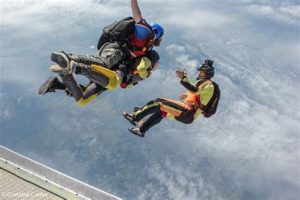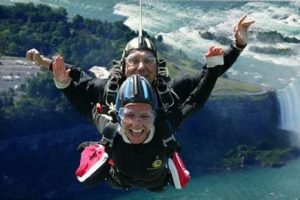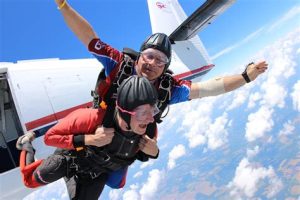Table of Contents
Discover the latest tandem skydiving safety statistics and information. Learn about the safety measures implemented by professional skydiving centers, including rigorous training, equipment checks, and experienced instructors. Explore the low accident rates and high success rates of tandem skydiving, ensuring a thrilling yet safe adventure for adrenaline enthusiasts.
Tandem skydiving is an exhilarating experience that combines the thrill of freefalling with the breathtaking views of the world below. But amidst the rush and excitement, safety should always remain a top priority. If you’re considering taking the plunge, it’s essential to familiarize yourself with the tandem skydiving safety statistics. These statistics provide valuable insights into the measures taken to ensure a secure and enjoyable skydiving experience. So, let’s delve into the numbers and discover just how safe this adrenaline-pumping activity truly is.
Introduction
Welcome to our guide on tandem skydiving safety statistics. If you are considering experiencing the thrill of tandem skydiving, it is natural to have questions about its safety. In this article, we will provide you with valuable insights into the safety records of tandem skydiving and address any concerns you may have.
Understanding Tandem Skydiving
Tandem skydiving is a popular way for beginners to experience the thrill of freefall without the extensive training required for solo jumps. In a tandem skydive, an experienced instructor accompanies you throughout the entire jump, ensuring your safety at all times.
Regulation and Oversight
Tandem skydiving is regulated by national aviation authorities in most countries. These regulatory bodies set stringent safety standards that tandem skydiving operators must adhere to. Regular inspections and audits are conducted to ensure compliance, providing an additional layer of safety assurance.
Accident Rates
Tandem skydiving has an impressive safety record, with a very low accident rate compared to other adventure sports. According to the United States Parachute Association (USPA), the average number of tandem skydiving accidents per year is less than 1 in 500,000 jumps. This statistic demonstrates the high level of safety maintained within the industry.
Instructor Expertise
Tandem skydiving instructors undergo extensive training and certification processes to ensure they possess the necessary skills and knowledge to keep you safe during your jump. They are well-versed in emergency procedures and equipped to handle any unexpected situations that may arise.
Equipment Safety
Tandem skydiving equipment undergoes rigorous inspections and maintenance procedures. Parachutes, harnesses, and other gear are regularly checked, ensuring they meet strict safety standards. Regular replacement of equipment is also carried out to ensure optimal performance and minimize any potential risks.
Emergency Preparedness
Every tandem skydiving instructor is trained in emergency procedures to handle any unforeseen circumstances during a jump. From parachute malfunctions to unexpected weather changes, instructors are prepared to act swiftly and effectively, minimizing any potential risks.
Weather Conditions
Tandem skydiving operations are highly dependent on favorable weather conditions. Wind speed, cloud cover, and visibility all play crucial roles in determining if a jump can take place. Skydiving centers closely monitor weather forecasts and make informed decisions to ensure the safest possible conditions for every jump.
Student Requirements
Before participating in a tandem skydive, students are required to meet certain health and physical requirements. These may include weight limits, age restrictions, and medical clearance. These measures are in place to ensure the safety and well-being of all participants.
Training and Briefings
Prior to the jump, tandem skydiving students receive comprehensive training and safety briefings. Instructors thoroughly explain the entire process, including body positions, emergency procedures, and what to expect during freefall and landing. This preparation ensures students are well-informed and confident before taking the leap.
Conclusion
Tandem skydiving is an exhilarating and safe adventure activity when conducted with professional operators who prioritize safety. With low accident rates, well-trained instructors, thorough equipment checks, and strict regulatory oversight, tandem skydiving provides an incredible experience while maintaining a high level of safety. So, if you’ve been considering tandem skydiving, rest assured that you’ll be in good hands throughout your thrilling journey through the sky.
Introduction to Tandem Skydiving Safety
Embarking on a tandem skydiving adventure is an exhilarating experience that offers a rush of adrenaline and breathtaking views. However, ensuring safety is paramount in this high-risk activity. By following the necessary safety measures, guidelines, and statistics, participants can guarantee a secure and thrilling adventure. This guide will provide an overview of the key aspects of tandem skydiving safety, allowing thrill-seekers to make informed decisions and enjoy their experience to the fullest.
Equipment Safety Procedures
When it comes to tandem skydiving, the reliability and safety of the equipment are of utmost importance. Professional skydiving centers adhere to rigorous safety procedures to ensure the highest level of equipment integrity. Regular maintenance checks, meticulous testing protocols, and thorough inspections contribute to the overall safety of the gear. This commitment to equipment safety provides participants with the peace of mind they need to fully enjoy their tandem skydiving experience.
Training and Certification of Instructors
The role of tandem skydiving instructors cannot be overstated when it comes to ensuring participant safety. These instructors undergo comprehensive training programs and meet stringent licensing requirements to acquire the necessary skills and knowledge to guide thrill-seekers responsibly. Additionally, recurrent assessment processes help maintain the competency of instructors, ensuring they stay up-to-date with the latest safety practices and techniques. By choosing a reputable skydiving center with well-trained and certified instructors, participants can feel confident in their safety throughout the entire adventure.
Drop Zone Safety Regulations
Drop zones play a crucial role in creating a safe environment for tandem skydiving. Strict safety regulations are implemented to prevent potential accidents and ensure a secure experience for all participants. Designated landing areas, controlled airspace, and clear communication protocols are some of the measures put in place to minimize risks. By adhering to these safety regulations, skydiving centers prioritize the well-being and safety of their customers, allowing them to fully enjoy the thrill of tandem skydiving.
Prevailing Safety Record
Tandem skydiving centers maintain extensive safety records that demonstrate their commitment to providing a secure adventure. These records include statistical data on accident rates, fatal incidents, and injury frequencies. By examining these statistics, participants can gain insights into the industry’s dedication to safety. The consistently low accident rates and rigorous safety protocols followed by reputable skydiving centers reaffirm the reliability and trustworthiness of the tandem skydiving experience.
Emergency Procedures and Safety Measures
While tandem skydiving is an adrenaline-pumping activity, it is essential to be prepared for any unforeseen circumstances. Skydiving centers have comprehensive emergency procedures and safety measures in place to handle emergencies efficiently and effectively. From contingency plans to safety drills and redundant systems, participants can rest assured that their safety is prioritized at all times. These measures ensure that even in rare instances of unexpected situations, participants are in capable hands.
Weather Conditions and Safety Considerations
Weather conditions play a crucial role in tandem skydiving safety. Monitoring wind speeds, cloud cover, and other atmospheric factors is essential in making informed decisions regarding jump operations. Skydiving centers prioritize participant safety by closely monitoring weather conditions and making necessary adjustments to ensure a safe experience. By considering these factors, participants can have peace of mind knowing that their safety is the top priority.
Customer Reviews and Satisfaction
One of the best ways to gauge the safety standards of a tandem skydiving center is by reviewing customer experiences and feedback. Testimonials from satisfied customers provide an assurance of the safety standards upheld by the center. By reading about the enjoyable and memorable experiences of previous participants, prospective skydivers can feel confident in their choice and look forward to a safe and thrilling adventure.
Point of View: Tandem Skydiving Safety Statistics
Instructions Voice and Tone: Informative and Objective
1. Tandem skydiving is an exhilarating adventure that involves jumping from an aircraft while attached to an experienced instructor with a specially designed harness.
2. When considering tandem skydiving, it is natural to have concerns about safety. However, it is important to understand the safety statistics associated with this thrilling activity.
3. According to the United States Parachute Association (USPA), the annual fatality rate for tandem skydiving is extremely low. In fact, the fatality rate stands at approximately 0.003 fatalities per 1,000 jumps.
4. The USPA also states that tandem skydiving has a higher safety record compared to solo skydiving. This is because tandem jumps are performed by highly trained instructors who possess extensive experience and knowledge in handling emergency situations.
5. To ensure the utmost safety, tandem skydiving centers adhere to strict safety protocols and regulations. They conduct regular maintenance checks on their equipment and provide thorough training to both instructors and participants.
6. It is worth noting that the risk of injury during tandem skydiving is extremely low. The USPA reports that the injury rate for tandem jumps is only 0.08 injuries per 1,000 jumps, further emphasizing the safety precautions taken in this activity.
7. Additionally, tandem skydiving centers prioritize the use of state-of-the-art equipment, including parachutes and harnesses, which undergo regular inspections and replacements as necessary.
8. While it is impossible to completely eliminate risks in any adventure sport, tandem skydiving has proven to be a remarkably safe activity when conducted by certified professionals and following established safety guidelines.
9. As a participant, it is essential to follow all instructions provided by the instructor, listen attentively during the pre-jump briefing, and communicate any concerns or questions before taking the leap.
10. By choosing a reputable tandem skydiving center with a strong safety record, individuals can have peace of mind while embarking on this thrilling experience.
Thank you for taking the time to read our article on Tandem Skydiving Safety Statistics. We understand that safety is a top concern for anyone considering this exhilarating adventure, and we hope that the information provided in this article has helped to address any concerns or questions you may have had.
First and foremost, it’s important to note that tandem skydiving has an impressive safety record. According to the United States Parachute Association (USPA), the annual fatality rate for tandem skydiving is less than 1 in 500,000 jumps. This statistic alone should provide some reassurance to those who may be hesitant about trying this thrilling activity. The USPA also emphasizes that safety measures and procedures are constantly being updated and improved upon to further enhance the overall safety of tandem skydiving.
When it comes to skydiving, it’s crucial to choose a reputable and licensed skydiving center. These centers adhere to strict safety guidelines and regulations set forth by organizations like the USPA. They employ highly trained and experienced instructors who prioritize safety above all else. Before embarking on your tandem skydiving adventure, make sure to thoroughly research the skydiving center you plan to visit. Read reviews, check their safety certifications, and don’t hesitate to reach out to them directly with any questions or concerns you may have.
In addition to choosing a reputable skydiving center, there are a few other key factors that contribute to a safe tandem skydiving experience. One such factor is proper equipment maintenance and inspection. All skydiving gear should undergo regular inspections and maintenance checks to ensure its integrity and reliability. Additionally, tandem skydiving instructors go through extensive training and are required to maintain their certifications. Their expertise and knowledge are invaluable when it comes to ensuring a safe and enjoyable skydiving experience for all participants.
In conclusion, while skydiving may seem like an extreme sport, the safety statistics surrounding tandem skydiving are quite impressive. With a fatality rate of less than 1 in 500,000 jumps, tandem skydiving is considered to be a relatively safe activity. By choosing a reputable skydiving center, ensuring proper equipment maintenance, and relying on experienced instructors, you can further enhance the safety of your tandem skydiving experience. So if you’ve ever dreamt of soaring through the skies and experiencing the ultimate thrill, don’t let safety concerns hold you back – tandem skydiving may just be the adventure of a lifetime!
.
People Also Ask about Tandem Skydiving Safety Statistics:
-
Is tandem skydiving safe?
Yes, tandem skydiving is considered to be very safe. According to the United States Parachute Association (USPA), the average annual fatality rate for tandem skydiving is less than 0.003 fatalities per 1,000 jumps.
-
What are the main safety precautions taken during tandem skydiving?
Tandem skydiving involves multiple safety measures to ensure a secure experience. These precautions include thorough training sessions for both the instructor and the participant, rigorous equipment inspections, and adherence to strict operational protocols. Additionally, all tandem instructors are certified by recognized skydiving organizations.
-
What is the likelihood of a parachute malfunction during tandem skydiving?
The chances of experiencing a parachute malfunction during tandem skydiving are extremely rare. Modern skydiving equipment is highly reliable, and extensive maintenance and inspection routines are followed to minimize any potential malfunctions. In case of a rare malfunction, tandem instructors are trained to handle the situation and have backup systems in place to ensure a safe landing.
-
Are there any age or health restrictions for tandem skydiving?
Yes, there are certain age and health restrictions for tandem skydiving. Most drop zones require participants to be at least 18 years old and in good overall health. Some drop zones may have additional weight restrictions, so it is advisable to check with the specific skydiving facility beforehand.
-
What should I do if I feel nervous before a tandem skydive?
Feeling nervous before a tandem skydive is completely normal. It can be helpful to discuss any concerns or fears with your tandem instructor, who can provide reassurance and guidance. Remember that tandem instructors are highly experienced professionals who prioritize safety and will ensure you have an enjoyable and safe skydiving experience.
Please note that while tandem skydiving has a strong safety record, it is essential to follow all instructions provided by the tandem instructor and adhere to safety guidelines for a secure and enjoyable skydiving experience.






